VELO-CITY GLOBAL TAIPEI 2016 - DAY 01
27th of February
Government, Business and Advocacy united in the Opening Plenary of a Very Promising Velo-city Taipei
Opening Ceremony
 This morning’s Opening plenary of Velo-city 2016 in Taipei united the highest levels of city government, cycling industry and cycling advocacy: Deputy Mayor Charles Lin, commissioner for transport Anne Chung, president of bicycle manufacturer Giant, King Liu and president of the European Cyclists Federation (ECF) Manfred Neun. Only one man is absent, Mayor Ko, but for a good reason: the Mayor is cycling from the North to the South of Taiwan, an amazing one day tour de force of 380km to promote the Velo-city conference. Manfred Neun “Mayor Ko’s cycling is the strongest commitment we can have for Velo-city!”
This morning’s Opening plenary of Velo-city 2016 in Taipei united the highest levels of city government, cycling industry and cycling advocacy: Deputy Mayor Charles Lin, commissioner for transport Anne Chung, president of bicycle manufacturer Giant, King Liu and president of the European Cyclists Federation (ECF) Manfred Neun. Only one man is absent, Mayor Ko, but for a good reason: the Mayor is cycling from the North to the South of Taiwan, an amazing one day tour de force of 380km to promote the Velo-city conference. Manfred Neun “Mayor Ko’s cycling is the strongest commitment we can have for Velo-city!”
The city of Taipei is very proud to host the very first Velo-city in Asia and took the occasion of the Opening plenary to stress how much efforts they have taken in the last years to promote cycling. Commissioner Anne Chung clearly stated the government is working “hard to make our city safer, more sustainable and more liveable for our citizens. Since 2000, we have promoted cycling policies such as the Car Free Day, the extension of bike lanes, the Youbike bike share system, allowing bikes on trains and organising Velo-city to encourage more people to cycle.”
Deputy Mayor Charles Lin confirms that Taipei is looking to the future: they want an open government that is people oriented. And their acts show they mean it: Taipei city invests in better transport hubs, high speed rail, banned trucks out of the city centre, destroyed a huge overpass that was a barrier in the city in 168 hours. Specifically for cyclists, the city is going from 58km of bike paths to 190km in the next 3 years to form a real cycle network and doubling the Youbike system from 222 to 400 stations. Deputy Mayor Lin: “We are working towards our city vision for 2050, even though it costs money and causes conflicts.”
The cities are not alone, they can count on researchers, mayors of other cities, experts, industry and advocates for support - declared Manfred Neun - Many of these people are part of the 2016 Velo-city delegation and we will make sure the world realizes that less passive mobility is more active mobility, more access, more space for people and many more benefits that cycling brings for all, including the economy
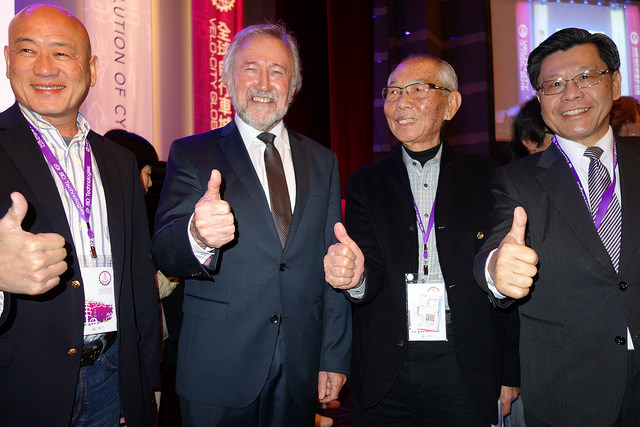 In Taipei, the bicycle manufacturer Giant shows the perfect example that you can do more together. Giant's President, King Liu has been promoting cycling culture for decades and as an 82-year cyclist himself, he is convinced of the benefits of cycling for health. Giant has also formed a team with the city administration to set up the Youbike bike share system. Again, this was not an easy job to introduce in Taipei, due to high numbers of scooters and cars, but Giant and the city managed to make the bike share successful, with up to 8,57 rides per bike per day, the highest turnover in the world according to King Liu! The secret for this success? Liu gives a simple but effective recipe: “High quality bikes and service, user friendly and hassle free registration, no deposit but public citizens control of good use of the bikes because the people love them so much. They are looking forward to Youbike coming to their neighbourhood.”
In Taipei, the bicycle manufacturer Giant shows the perfect example that you can do more together. Giant's President, King Liu has been promoting cycling culture for decades and as an 82-year cyclist himself, he is convinced of the benefits of cycling for health. Giant has also formed a team with the city administration to set up the Youbike bike share system. Again, this was not an easy job to introduce in Taipei, due to high numbers of scooters and cars, but Giant and the city managed to make the bike share successful, with up to 8,57 rides per bike per day, the highest turnover in the world according to King Liu! The secret for this success? Liu gives a simple but effective recipe: “High quality bikes and service, user friendly and hassle free registration, no deposit but public citizens control of good use of the bikes because the people love them so much. They are looking forward to Youbike coming to their neighbourhood.”
Velo-city definitely kicked off with a great and inspiring Opening Plenary, and Manfred Neun affirmed once more that Taipei is a leading example for other Asian cities!
Cycling will Change our Cities’ Face, but What do Mayors Think About that?
Sustainable Urban Development: the Mayors' Point of View

Day 1 at Velo-city 2016 Taipei ends with a bang! Six (vice)-mayors (one former) from 3 different continents explain how they see the evolution of cycling in their city.Stephen Yarwoord, former Lord Mayor of Adelaide (Velo-city 2014 host city) believestechnology will enhance the systematic evolution of cycling. From e-bikes to bike glasses with added reality and artificial intelligence, it will benefit to the chemistry of cognitive cities.
Vice Mayor Charles Lin of Taipei believes sharing economy is the game changer andmultimodal, well integrated transport for all. Taipei’s vision on transport is driven by “BBMW”, which is not the newest car, but stands for Bike, Bus, Metro, Walk oriented vision to manage mobility. The city Metro coverage is already 86% and this will be reinforced by a dense network of shared Youbikes (working towards 5min / 350meters walking between to stations), shared Youcars and shared electric Youmotorcycles. Taipei will also invest to become a Smart City but deputy Mayor Lin insists technology should be in function of people.
In Vienna (Velo-city 2013 host city), recently elected the world’s most liveable city and proud member of the Cities for Cyclists Network, redefining public spaces is key as they did with the 1,5km long shopping street Mariahilfe, that has been transformed into a shared space. A good mix of actions from the city, citizens and businesses can contaminate the city with the cycling virus. A good virus, as Vice Mayor Maria Vassilakou experienced with the launch of the bike share system: at the start it was chaotic, but people smiled, had fun. Vienna also gives citizens support to reclaim their streets and experiment.
Copenhagen (Velo-city 2010 host city) doesn’t come up with big secrets, but puts citizens in the centre of the debate. Copenhageners asked for change 30 years ago and cycle because it is fast and easy. So Vice Mayor Morten Kabell advises to make cycling the easy and natural option. Landmark cycling infrastructure is well invested money, he explains: “Our newest cycle bridge will be paid off in only 6 yearstime and 10 years of cycling investments are half the price of a car bypass of 3km. So get started with cycling, you will not regret it.”
The Japanese Mayors of the cities Onomichi and Imabari connected their cities with one of the world’s most beautiful bike routes across six islands “the Shimanami Kaido cycle route”. For them cycling tourism is the trigger for economic and social thriving. It has created a band between the two cities and their citizens and they are now working on new cycling routes.
The session was in the good hands of Philippe Crist, OECD, who was surprised by the Danish Cycling Embassy with this year’s Leadership Award for his outstanding knowledge and ongoing commitment to cycling worldwide.
The New Trend of the Cycling World: Cycle Highways on the Table today
Cycle Highways: Non-stop to Mass Transit by Bike
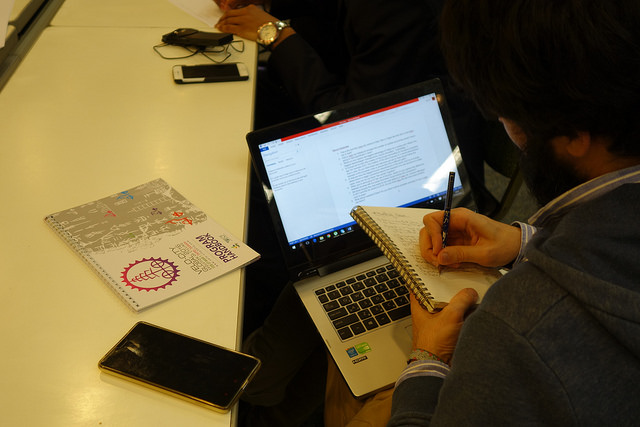 There has been much talk in the transport community about ‘cycle highways’ in recent year and its potential for getting people from cars onto the bike, in particular for commuting purposes. One of the best examples worldwide can be found in the Netherlands: the RijnWaalpad, connecting over 15 km’s the Dutch cities Arnhem and Nijmegen, both host of the Velo-city conference 2017. The person behind this cycle highway is Sjors van Duren who presented at this Velo-city workshop today.
There has been much talk in the transport community about ‘cycle highways’ in recent year and its potential for getting people from cars onto the bike, in particular for commuting purposes. One of the best examples worldwide can be found in the Netherlands: the RijnWaalpad, connecting over 15 km’s the Dutch cities Arnhem and Nijmegen, both host of the Velo-city conference 2017. The person behind this cycle highway is Sjors van Duren who presented at this Velo-city workshop today.
Even in a cycle-friendly country like the Netherlands, Sjors met - to his big surprise - resistance among local people who were against the project. They associated with it, initially, a motorway highway which stands for noise and air pollution, a reason why Sjors does not like the name ‘highway’. According to him, a cycle highway should also not be so much about speed but about convenience. “People will prefer taking a longer over a shorter route if it’s short in their mind.”
Crucial to an acceptance of a cycle highway among the people is also to get it into their mental map with good signposting and lightning – something the RijnWaalpad has done in an exemplary manner. Come and find out yourself next year at Velo-city Arnhem-Nijmegen!
The World's top Cycling Embassies shared their Secrets on Cycling Advocacy
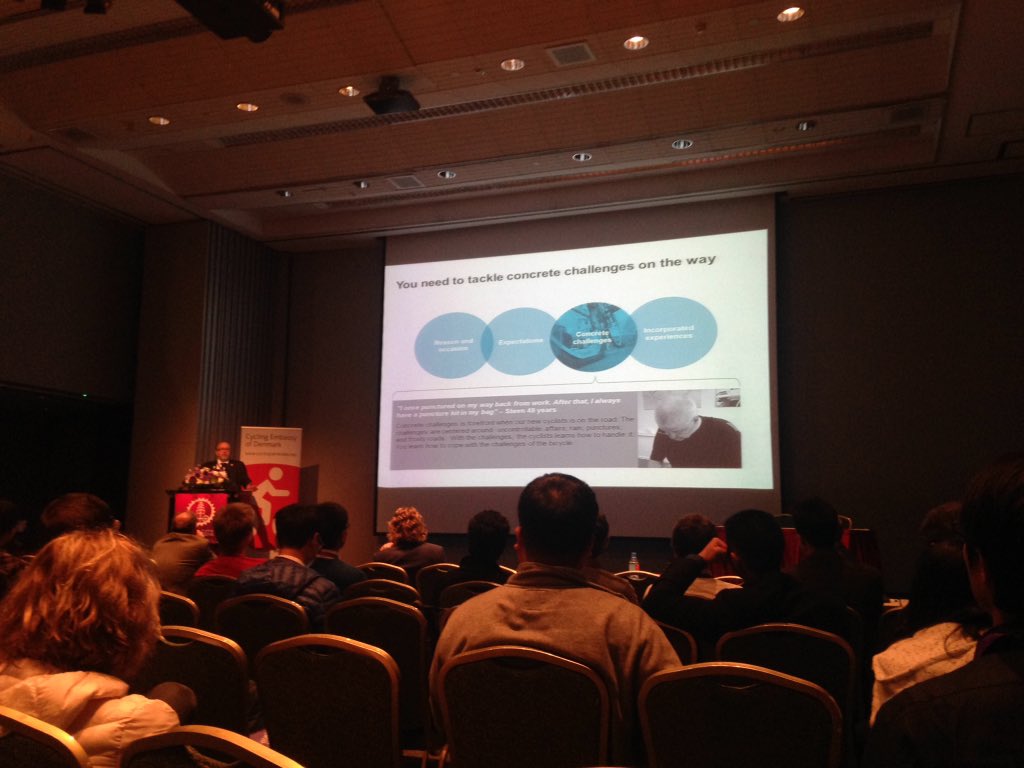
The Secret Behind Denmark’s Cycling Success
Some figures first: the bicycle is used for 17% of the trips in Denmark; in Copenhagen, 50% of children cycle to school, 99% of kids under 10 years old know how to cycle; 45% of the commute trips in Copenhagen are done by bike. But even the Danish capital city has not always been the bicycle heaven it is today: "The levels of cycling the city sees today are the result of a long-term persistent and hard work" says Niels Hoe, one of the 3 presenters of the Danish Cycling Embassy at the workshop.
The evolution of cycling in Copenhagen can be well seen at Norrebrogade, one of the main traffic hot spots in the city. While in 1949 still 62,000 daily cyclists passed this intersection, the figure drop by more than 85 % to 8,200 in 1978. Since then it has bounced back to 42,000. What triggered that change? "The people of Copenhagen demanded it" said Klaus Bondam, combined with visionary thinking from city planner Jan Gehl. But even in cities like Copenhagen not all fights are fought yet: when car parking places are to be removed, shopkeepers complain; and "although the investments in cycling are significant (in the period 2005–2016 1 billion DKK/133 million Euro were spent), other modes still get more money" Marie Kastrüp added. Even in Copenhagen things can still be improved.
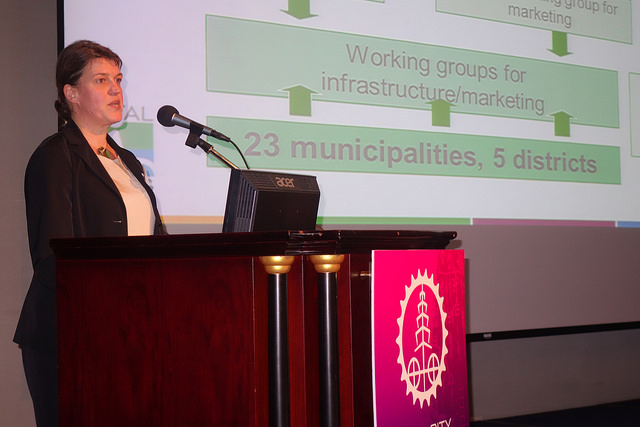
German Embassy Shared their Expertise in Cycling Tourism
The cycling tourism sector generates more than 9 billion Euro economic impact per year in Germany. Its not a surprise because 26 million germans are making day trips and 6 million Germans do cycle holidays (with overnight) per year. This mean German cycling tourism generates 10% of all tourism incomes in Germany. Burkhard Stork, CEO of ADFC (the German Cyclists' Association), revealed the 3 secrets to Germany’s cycle tourism success: 1. They operate with high quality products, 2. They have one route operator fully responsible for all components (infrastructure, services, promotion) of each route, 3. They operate with wide target groups not focusing on a niche market. Louise Böhler explained how they ensure this quality using the Bett&Bike system and the certification standard developed and dlivered by ADFC. Claudia Kreiger explained how does this work in practice in case of the Ruhr Valley Cycle Route.
The Data we Have, The Data we Use: Apology of Data Analysis in Cycling
The Data we Have, The Data we Use
 Cycling planners, decision-makers, and advocates all need reliable and up-to-date data to measure the performance of infrastructure, to address shortcomings and to improve user satisfaction. The session “The Data We Need, The Data We Use” featured innovative approaches to data collection from the global to the local level.
Cycling planners, decision-makers, and advocates all need reliable and up-to-date data to measure the performance of infrastructure, to address shortcomings and to improve user satisfaction. The session “The Data We Need, The Data We Use” featured innovative approaches to data collection from the global to the local level.
The presentations started off with the 2015 Worldwide Cycling Index, based on an aggregation of data from automated counters from countries all around the world. Next in line was the Global High Shift Cycling study by the University of California Davis and the Institute for Transport and Development (ITDP), which includes acomprehensive set of cycling modal share data from cities around the globe and shows that it would be possible to reach a modal share of 23% for cycling in 2050, creating huge benefits in terms of CO2 emissions savings and saving large amounts of money for cities. The third presentation introduced an innovative app developed in Austria to track cyclists’ daily routes and retrieve data on for example their average speed in different street sections.
The ensuing debate focused on the usability of the different data presented in advocacy and decision-making in concrete cases.
From eBikes to eScooters: don't ask If, but When the Shift will Come
From (e-)scooters to (e-)bikes? A question of safety
This session discussed the rise and use of electric powered active two wheelers. Tien-ben Hsu, from the University of Taipei, started by comparing safety risks between bicycles, eBikes and eScooters from the viewpoint of Taipei.
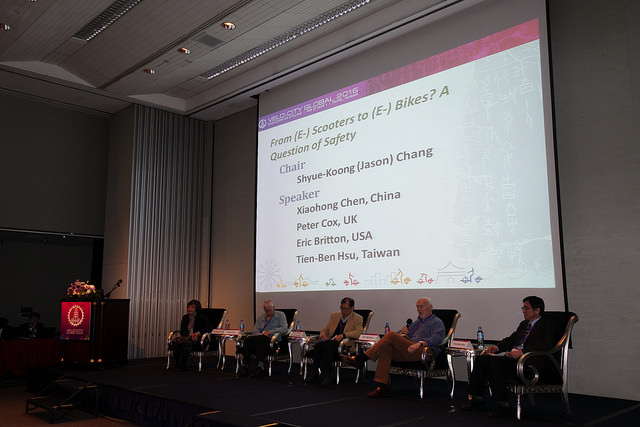 Tien-ben Hsu affirmed that in Taipei fatalities have actually been decreasing for bikes and eBikes, though serious injuries have increased. Within the two wheel modes a big risk difference between bicycles, eBikes and motorcycles were with regards to age: it seems that elderly cyclists are a far riskier group compared to motorbikes and scooters. The main difference between the types of collision with bicycles is the increased risk coming from a car cutting across when turning: however,bicycles proved to be at a much lower risk than motorbikes, in this respect.
Tien-ben Hsu affirmed that in Taipei fatalities have actually been decreasing for bikes and eBikes, though serious injuries have increased. Within the two wheel modes a big risk difference between bicycles, eBikes and motorcycles were with regards to age: it seems that elderly cyclists are a far riskier group compared to motorbikes and scooters. The main difference between the types of collision with bicycles is the increased risk coming from a car cutting across when turning: however,bicycles proved to be at a much lower risk than motorbikes, in this respect.
“The situation in China is rather different” declared Xiaohong Chen, from Tonji University. Given thesubstantial lack of segregated bike lanes, all road users share the same space, which easily results in an increased extra danger for bicycles. Nevertheless, the absolute and relative data lead to the conclusion that the eBike and eScooter trends in China are not as dangerous as it was feared at first.
On his behalf, Peter Cox from the University of Chester introduced another point of view: in his opinion, a comprehensive understanding of the street dynamics is crucial:
How and why we differentiate between different 2 wheeler modes of transport are fundamental questions, since rather than regulating vehicles by motor power or size, speed, aerodynamics and acceleration should be considered
In conclusion, this session clearly demonstrated that essentially good education, understanding and infrastructures are the most important aspects to improve safety in urban areas; and even the most concerning data should not prevent the further development of human and electric powered vehicles. As stated by Eric Britton, working with EcoPlan International, “electric vehicles agenda is to be strongly promoted in order to combat the huge threat to human existence that global warming represents.”
Number of Bike Theft Destined to Fall: Smart Parking Solutions are on the way
Smart Parking Solutions
Space in urban areas is at an absolute premium and Public Bike Sharing systems must find the best way to use the space available.
The opening declaration of Shravan Shah, professor at CEPT University and active in the Centre for Green Mobility in Ahmedabad, pointed directly at the main issue, when talking about parking solutions. Starting with the bike dimension and working through to the use and manipulation of the bike at the stations, he spoke about the need to find an optimum layout and storage of bikes at docking stations. A good Bike Share should combine ease of access, good dock design, safe locking and cleaning facilities, and if possible shelter and an easy to find design. Space for non Bike Share users should also be a consideration.
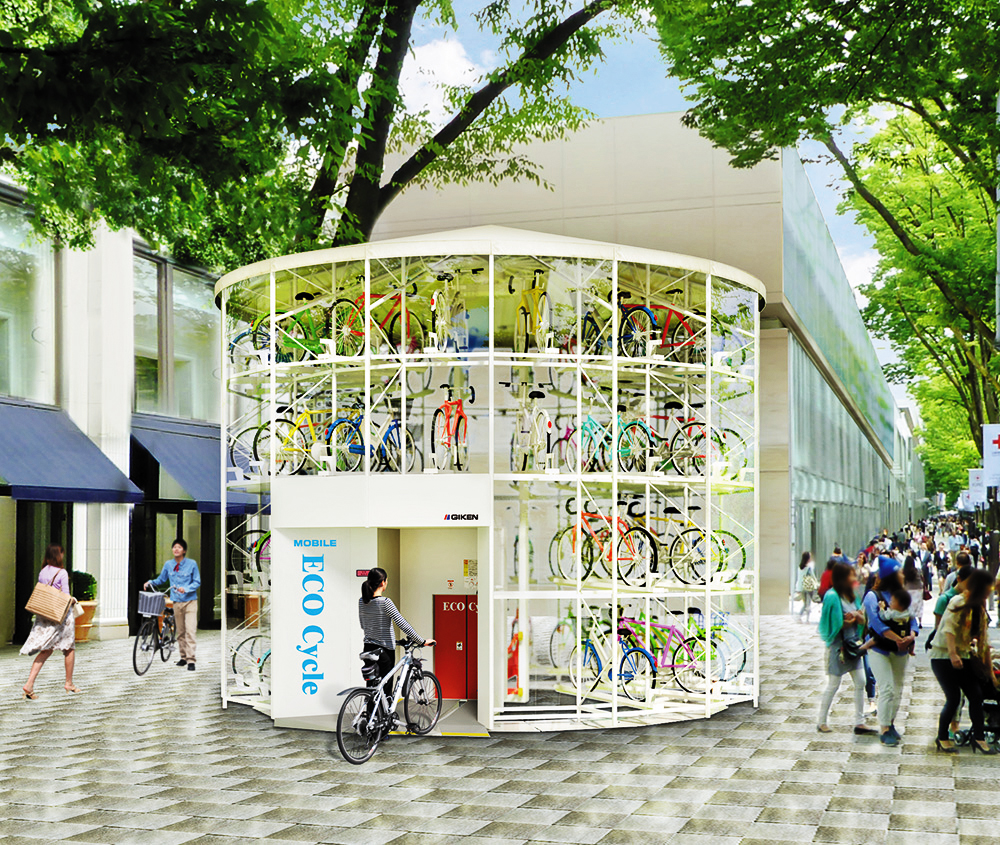 Tzu Yang Chiu, head of Taipei City Parking Management and Development, stated that Taipei is ambitiously targeting a cycling modal share of 12% by 2020, which means that bicycle parking has to be taken off at an early stage. The main idea for Taipei is to have cycling compete with motorbikes,and for cycling to have its own area for parking not mixed with motorbikes or scooters. “This willencourage cycling as well as improving the city appearance” concluded Yang Chiu.
Tzu Yang Chiu, head of Taipei City Parking Management and Development, stated that Taipei is ambitiously targeting a cycling modal share of 12% by 2020, which means that bicycle parking has to be taken off at an early stage. The main idea for Taipei is to have cycling compete with motorbikes,and for cycling to have its own area for parking not mixed with motorbikes or scooters. “This willencourage cycling as well as improving the city appearance” concluded Yang Chiu.
Presenting the innovative Eco-Cycle underground and over ground parking solutions, Tsunenobu Nozaki from Giken said that “To clear away the clutter of bikes being left in public spaces, the solution is to build up and down into the ground!” This new structure takes the bike, numbers the bike and stores it in the most efficient and safe way possible.
Martijn te Lintelo from Nijmegen public authority, the Dutch Cycling Embassy and Fietsberaad gave us the Dutch perspective! Parking must be seen as an integral part of the journey, and as essential for intermodality with public transport. The first ingredient is to have an integrated mobility approach rather than just providing cycling facilities. Quality and well designed racks which deter theft should be seen as essential everywhere cycling is promoted as an everyday mode of transport: the Dutch experience demonstrates that good bike parking provides comfortable last mile delivery, links the bike to public transport and boosts retail sales with shopping by bike.
The session has been well managed by ECF's Policy Officer Ceri Woolsgrove.
沒有留言:
張貼留言